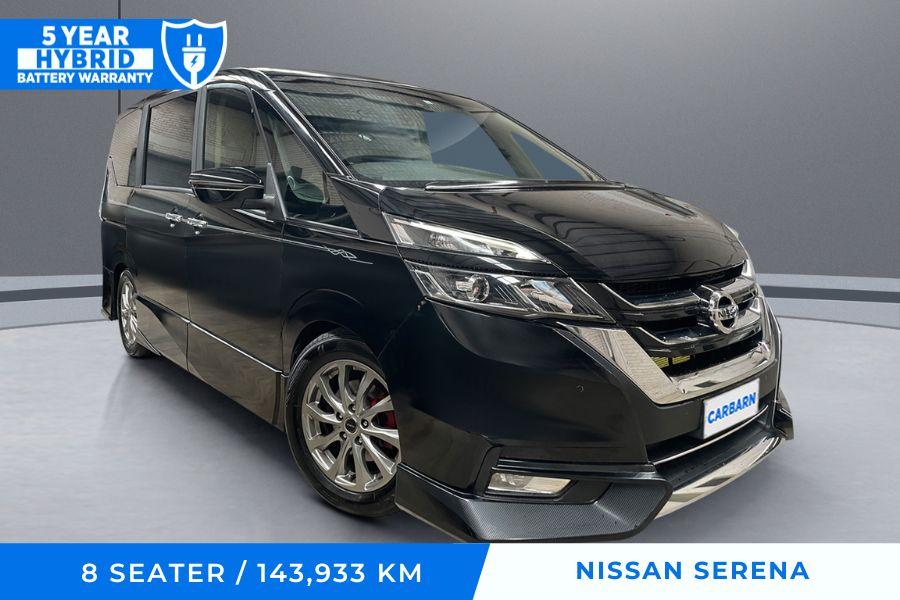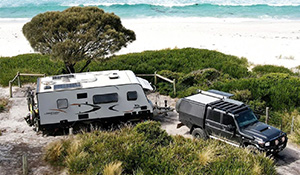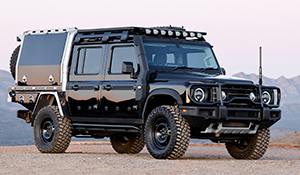Mercedes-Benz G-Wagon is ultimate off roader
While the result was an incredible vehicle, spartan in appearance, it had little success securing military contracts. Rather than scrapping it entirely, Benz took the functional cross country vehicle, added some convenience items and offered it to a civilian market.
Public launch
The 'Gelaendwagen' (the G-wagon, "G" standing for Gelande - German for terrain) was launched at the Geneva Motor Show in 1979. It was offered in two wheelbases with five body styles and four engine choices. All models were available with either 2WD (with optional diff lock) or 4WD (with optional dual diff locks). The body styles were the two-door 'canvas-top' car, 2-door SWB station wagon, 4-door LWB station wagon, SWB 2-door van, or LWB 4-door van. There was a variety of seating options from two to nine passengers. In all, some 40 variations were offered.
G-Wagon concept
There is no escaping that the G-Wagon was designed primarily as a military vehicle, and while many expected Benz to design a 4WD to challenge the off road superiority of Range Rover, the concept was strictly to build a functional, all-terrain 4WD vehicle for sale to military services.
Accordingly, the vehicle followed the successful formula of Steyr-Daimler-Puch, with utilitarian flat panels, short approach and departure angles and a large range of bolt on accessories. The design brief specified that the G-Wagon range had to meet both road and rough country use, versatility of body designs for many purposes, longevity of service, the use of components already in existence and ease of repair.
Running gear and engines
The G-Wagon used Mercedes-Benz powertrains and running gear produced in Stuttgart and assembled in Austria at the new Steyr-Daimler-Puch factory in Graz. Four engines were offered - two petrol and two diesel. The diesels were the 240GD 2.4-litre and the 300GD 3.0-litre. The petrol versions were the 230G 2.3-litre and 280GE 2.8-litre 6-cylinder.
Transmission was either a four-speed manual or automatic, with dual range part time 4WD transfer case, running to two manually lockable differentials in live axles. Suspension was coil springs and telescopic shock absorbers.
The G-Wagons were designed with a rigid box-section chassis, onto which bodies were bolted. The main fuel tank was located behind the rear axle with two additional tanks located at the rear of the back wheel arches. Total capacity was 100-litres. The majority of parts used in the G-Wagons were sourced from existing Mercedes vehicles, with the chassis frame, bodies, live front axle and transfer case the only all-new components.
With full production at Graz, 11,000 G-Wagons were produced annually. Mercedes celebrated 30 years of the G-Wagon in 2009, with more than 200,000 having been delivered. The G-Class also enjoys the title of the longest serving passenger vehicle series in the 125-year history of Mercedes-Benz.
Continuous model updates keep the G-Class up to the latest technological development status and guarantee a superior drive system, but without diluting its essential character. Thanks to a combination of permanent all-wheel drive, the electronically controlled traction system 4ETS, ESP, a "low-range" gearbox and three selectable differential locks, the G-Class is equal to any off-road challenge while ensuring the handling safety expected of a Mercedes on the road.
The current model family is available in three body variants (short-wheelbase Station Wagon, long-wheelbase Station Wagon, Convertible), which can be combined with either the economical V6 CDI engine developing 165 kW and 540Nm, or a powerful 5.5-litre V8 petrol engine with 285 kW and 530Nm. The top of the range G 55 AMG, which is available only as a four-door, long-wheelbase Station Wagon, has a supercharged V8-engine generating an output of 373 kW and an impressive maximum torque of 700Nm. The result is shattering performance that combines with an incomparable sound to characterise this particularly sporty version.
G-Class in Australia
The G-Wagon first arrived in Australia in 1982, with just 100 300GD 4WD wagons available. A SWB model was added in 1985. The first petrol model - the SWB 230GE petrol - was introduced at the 1986 Melbourne Motor Show. The biggest criticism of the G-Wagon was its high cost and the model faded from the Australian market. The good news however is that in 2011 the G-Wagon will again be offered by Mercedes-Benz in Australia.
G-Class evolution
1973: The first model of the future Mercedes cross-country vehicle is presented in April.
1974: The first ready-to-drive prototype is sent out for testing.
1975: A second feasibility study confirms the prospects of success for a Mercedes-Benz off-road vehicle.
1979: The G-Model is presented to the press for the first time. Production gets underway on February 10, 1979 with the 240 GD, 300 GD, 230 G and 280 GE first off the assembly line.
1980: An enclosed van-type model with short or long wheelbase is added to the model range.
1981: The first facelift: automatic transmission, air conditioning, bench seats for the load area, an additional fuel tank, a "tropical roof", protective headlamp grilles, a cable winch, a hardtop for the Cabriolet and a mechanical power take-off are all available as options for the 280 GE and 300 GD. Customers can choose from a total of 22 different paint colours, up from the previous five.
1982: The new 230 GE with mechanical fuel injection and 92 kW replaces the 230 G with a carburettor engine. Recaro seats, auxiliary heating, wide-base tyres for the light-alloy wheels and wheel arch flaring can be ordered as options.
1983: The 230 GE is optionally available with a four-speed automatic transmission. The second facelift sees four new metallic colour shades and a five-speed transmission added to the list of equipment.
1985: Differential locks, central locking and a rev counter are added to the list of standard equipment as part of the third facelift.
1986: In July, the 50,000th G-Class rolls off the assembly line.
1987: The fourth facelift brings new optional extras: power windows, an automatic aerial and a combined luggage cover and retaining net for the load area. The chassis with cab and 3.12-metre wheelbase is added to the range.
The 250 GD developing 62 kW replaces the 240 GD.
Planning begins for the later 463 series.
1988: The driver's and front passenger's seats are fitted with armrests.
1989: The 230 GE Classic limited-edition model is presented to mark the10th birthday of the G-Class. A total of 300 units are built.
The new 463 series with permanent four-wheel drive, an exquisite wood interior and optional ABS is presented in September at the International Motor Show in Frankfurt.
1990: The 463 series is launched in April in the shape of the 230 GE, 300 GE, 250 GD and 300 GD models. Customers can choose from three body variants. End of production of the 460-series 280 GE and 300 GD.
1992: G-Class production begins in Greece, with the CKD (Completely Knocked Down) vehicles delivered in separate parts to the assembly site.
Market launch of the 461 series for professional users - a revised version of the previous 460 series. The model range comprises the 230 GE and the new 290 GD, which replaces the previous 250 GD.
First model facelift of the 463: cruise control, a spare wheel cover of stainless steel, running-boards, a luggage compartment cover and burr walnut trim are available on request.
The new 350 GD Turbodiesel is unveiled in May.
In June, the 100,000th G-Class off-roader leaves the assembly line.
1993: A chassis with cab and 3.40-metre wheelbase is added to the 461-series range. The 8-cylinder 500 GE special-edition model is unveiled, offering luxurious equipment and trim levels and limited to 500 units. Its V8 engine develops 177 kW.
The "G" prefix is introduced: the G-Models are now officially called the G-Class, with model designations such as G 230, G 300, G 350 Turbodiesel, etc.
1994: The second facelift of the 463 series sees the introduction of internally ventilated front disc brakes and a driver airbag as standard.
The 155-kW G 320 model replaces the outgoing G 300.
1995: All G-Class models are fitted with remote-controlled central locking and an immobiliser.
1996: The G 300 Turbodiesel with 130 kW and an electronically controlled five-speed automatic transmission is presented. It replaces the G 350 Turbodiesel.
Model facelift and upgraded standard equipment, with a headlamp cleaning system, cruise control and a front passenger airbag.
1997: The G-Class Convertible with a powered soft top is presented.
The G 320's V6 engine replaces the six-cylinder in-line power unit in the 463 series. The electronically controlled five-speed automatic transmission is fitted as standard in the G 320.
The 290 GD Turbodiesel with 88 kW replaces the 290 GD with naturally aspirated diesel engine in the 461 series.
1998: Fourth facelift: The range-topping new 500 (218 kW) joins the G 320 and G 300 Turbodiesel in the G-Class family.
1999: In March, the exclusive G 500 Classic special-edition model is presented to mark the 20th anniversary of the G-Class. Production is limited to 400 vehicles. The multi-function steering wheel is added to the list of standard equipment for the G-Class.
The G 55 AMG takes to the stage. Its V8 engine delivers 260 kW.
The Mercedes-Benz G 500 Guard appears in three different special-protection versions.
2000: The new 2001 models are unveiled at the Paris Motor Show - with a new interior offering further enhanced levels of comfort.
The new diesel model G 400 CDI with a new V8 diesel engine (184 kW) replaces the G 300 Turbodiesel.
The V8 models are fitted with new light-alloy wheels, a chromed radiator grille and bumpers in the body colour.
2001: The G-Class is presented with new dynamic control systems. These include the Electronic Stability Program ESP,Brake Assist and the Electronic Traction System 4ETS. The G-Class is launched in the USA.
2002: The new G 270 CDI makes its debut powered by a 115-kW five-cylinder diesel engine.
2004: World premiere of the new G 55 AMG with a supercharged V8 engine developing 350 kW at the Geneva Motor Show.
The G-Class celebrates its 25th birthday.
2006: The G 55 AMG now has an output of 368 kW.
Bi-xenon headlamps, foglamps with cornering lights and new, more scratch-resistant nano-particle paint finishes are offered for the first time.
The G 320 CDI replaces the diesel models G 270 CDI and G 400 CDI. At the same time the G 320 is discontinued.
2007: The final development stage of the G 55 develops an output of 373 kW/507 hp.
A new instrument cluster with four analogue dial instruments, a modified centre console with new controls and switches, and a new four-spoke steering wheel form the control centre from this model year onward.
The control and display system COMAND APS with a DVD navigation system, integrated radio, CD-player and telephone keypad becomes standard equipment (optional for the G 320 CDI).
New tail light clusters are given brilliant LED technology.
New optional extras include a reversing camera, a tyre pressure monitoring system and the "ARTICO" interior package with robust man-made leather.
2008: The G 500 receives a new 5.5-litre V8-engine with 285 kW and a torque of 530 Nm.
The G-Class features a modified radiator grille in a 3-louvre design.
At the same time the new-generation telematics with fast HDD navigation, and Bluetooth interface for mobile phone operation are introduced.
2009: The G-Class celebrates its 30th birthday.
Mercedes-Benz presents the special Edition30 and Edition30 G.PUR models to mark the anniversary.













